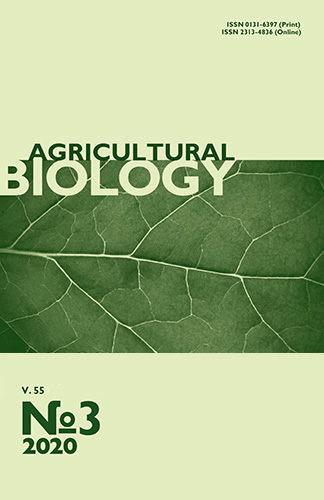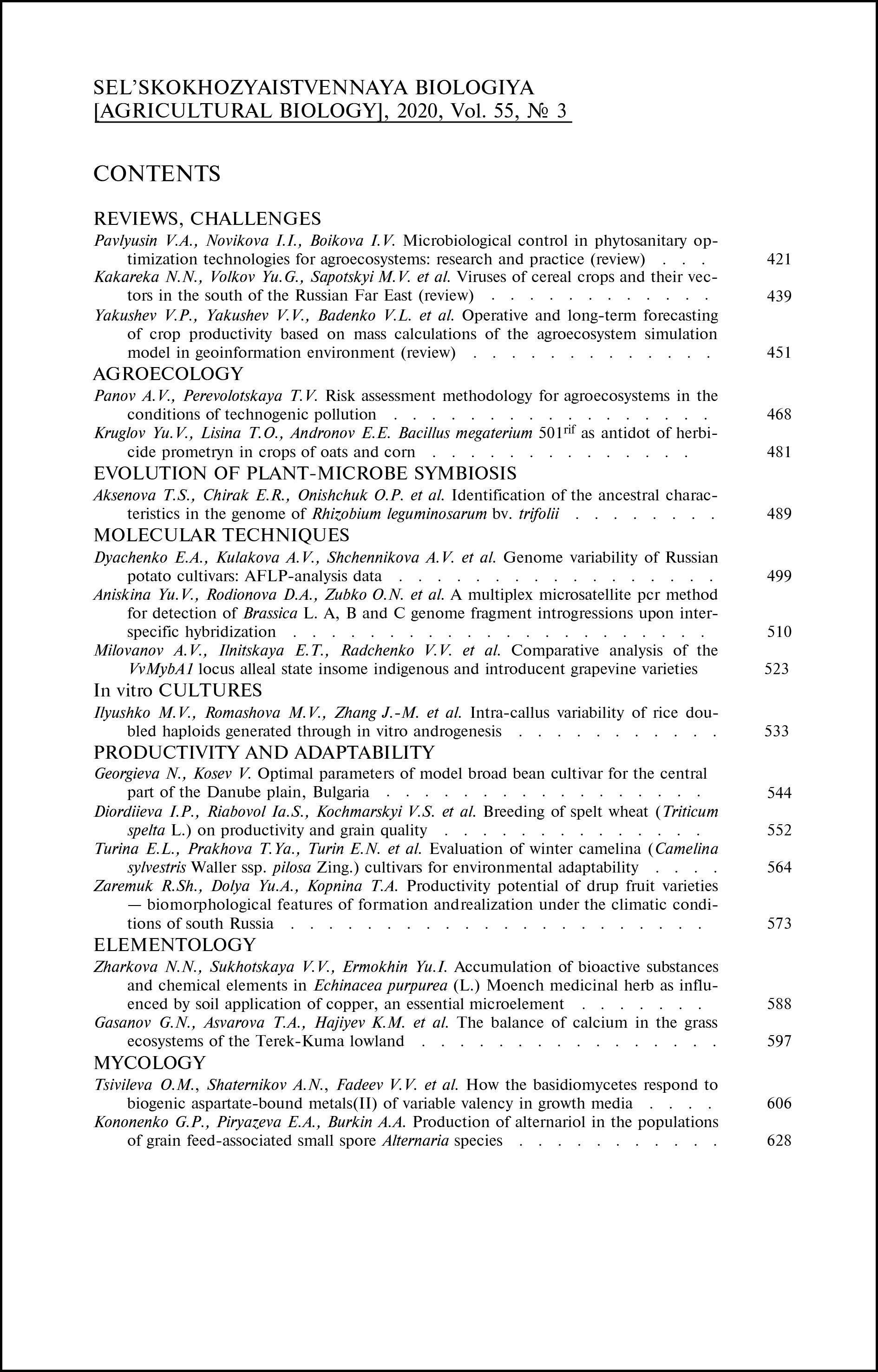doi: 10.15389/agrobiology.2020.3.597eng
UDC: 633.2.03:574.4:581.192(470.67)
Acknowledgements:
Supported by the Presidium RAS program No. 112P “Biodiversity of natural systems. Biological resources of Russia: state assessment and fundamental principles of monitoring”
THE BALANCE OF CALCIUM IN THE GRASS ECOSYSTEMS
OF THE TEREK-KUMA LOWLAND
G.N. Gasanov1, 2, T.A. Asvarova1, K.M. Hajiyev1,
R.R. Bashirov1, Z.N. Akhmedova1, A.S. Abdulaevа1,
Sh.K. Salikhov1, N.I. Ramazanova1, A.Sh. Gimbatov2,
M.R. Musaev2, N.R. Magomedov2, 3, R.Z. Usmanov1
1Precaspian Institute of Biological Resources, Dagestan Science Centre RAS, 45, ul. M. Gadjieva, Makhachkala, Republic of Dagestan, Russia 367000, e-mail nikuevich@mail.ru (✉ corresponding author), atacvar@mail.ru, kamil5555372@mail.ru, pakduik100@mail.ru, zaira-1945@mail.ru, aischat55@mail.ru, salichov72@mail.ru, nurjagan@yandex.ru, pibrdncran@mail.ru;
2Dzhambulatov Dagestan State Agricultural University, 180, ul. M. Gadjieva, Makhachkala, Republic of Dagestan, Russia 367000, e-mail daggau@list.ru, zaremka_76@mail.ru, musiska2014@mail.ru;
3Federal Agrarian Research Center of the Republic of Dagestan, 30, ul. A. Shahbanova, Makhachkala, Republic of Dagestan, Russia 367014, e-mail musiska2014@mail.ru
ORCID:
Gasanov G.N. orcid.org/0000-0002-6181-5196
Salikhov Sh.K. orcid.org/0000-0001-5531-3045
Asvarova T.A. orcid.org/0000-0002-5285-9250
Ramazanova N.I. orcid.org/0000-0001-9525-6292
Hajiyev K.M. orcid.org/0000-0003-1150-9593
Gimbatov A.Sh. orcid.org/0000-0003-2801-2276
Bashirov R.R. orcid.org/0000-0002-6331-2592
Musaev M.R. orcid.org/0000-0002-3170-2086
Akhmedova Z.N. orcid.org/0000-0002-7141-939Х
Magomedov N.R. orcid.org/0000-0003-3871-0932
Abdulaevа A.S. orcid.org/0000-0001-9056-1909
Usmanov R.Z. orcid.org/0000-0002-4046-5991
Received August 20, 2018
Terek-Kuma lowland occupies the North-Western part of the Precaspian lowland. The soil-plant cover of the territory is determined by the aridity of the climate with frequent winds, light granulometric and saline soils, high pasture load. In this study, for the first time in the Terek-Kuma semidesert conditions, the productivity of structural parts of grass ecosystems and calcium reserves during the most favorable (April) and arid (August) periods are determined for the main soil types. The work aimed to determine the accumulation, distribution and reserves of calcium in the structure of phytomass with regard to a soil type. The research was performed at the Kochubey Biosphere Station, Precaspian Institute of Biological Resources of the Dagestan Scientific Center RAS in 2011-2016 on grass phytocenoses of light chestnut and meadow-chestnut soils and saline typical automorphic soils. Assessment of plant matter and Ca accumulation in green mass, rags, steppe felt, and roots, and calculation of the Ca budget of the ecosystems were carried out according to A.A. Titlyanova et al. (1988). The content of Ca in plants was determined by capillary electrophoresis (a Drops-105M system, Lumex, Russia) with special software Elforan (Lumex, Russia). The greatest amount of phytomass accumulated on light chestnut soil. On meadow-chestnut soil photosynthesizing parts, rags, steppe felt and roots accumulated 2.3, 1.5, 2.3 and 2.2 times less, respectively, and on typical saline soil 2.6, 1.7, 2.5 and 2.7 times less than on light chestnut soil. This was likely caused by a decrease in projective coverage from 77.0 % on light chestnut soil to 48.5 % on meadow chestnut soil and 43.5 % on typical saline soil. In the species patterns the dominants were Poaceae (51 % for light chestnut soil) and Asteraceae (30 % and 17 % for meadow chestnut soil and saline soil, respectively). The root weight for meadow-chestnut soil and typical saline soil was 2.2 and 2.9 times less than for light chestnut soil. Their share in the total phytomass depending on soil types ranged from 85.0 to 87.2 %. In green parts, the concentration of Ca, depending on the season and the soil type, was in the range of 0.40-0.48 %, in rags it was 0.50-0.54 %, in felt 1.00-1.31 %, and in underground parts 1.14-1.38 %. By soil types, it decreased as light chestnut soil > meadow-chestnut soil > saline soil due to pH changes (8.6 > 8.2 > 8.0), an increase in the degree of salinity and the shift of salinity from the sulfate type to the sulfate-chloride type. Reserves of Ca in the above-ground parts during the growing season on light chestnut soil amounted to 2.32 kg/ha per year and exceeded 2.7- and 3.1-fold, respectively, similar indicators for meadow-chestnut soil and typical saline soil. Ca reserves in the root mass for all types of soils were 12.6 times more than in the aboveground parts. After plant matter decomposition, steppe felt and underground organs contribute to light chestnut soil 42.0 and 58.0 % of the calcium consumed from the soil, to meadow chestnut soil 36.0 and 64.0 %, respectively; for the typical saline soil these amounts are 1.1- and 2.3-fold, respectively. It was revealed that the difference in the dynamics of Ca accumulation in components of a semi-desert plant community (green mass, rags, steppe felt, and roots) depends on the plant species composition, soil type and season.
Keywords: phytocoenosis, phytomass accumulation, plant matter translocation, Ca accumulation, Ca reserves, calcium budget.
REFERENCES
- Balamirzoev M.A., Mirzoev E.M.-R., Adzhiev A.M., Mufaradzhev K.G. Pochvy Dagestana. Ekologicheskie aspekty ikh ratsional'nogo ispol'zovaniya [Soils of Dagestan — environmental aspects of rational use]. Makhachkala, 2008 (in Russ.).
- Usmanov R.Z., Osipova S.V., Dzhalalova M.I., Babaeva M.A. Yug Rossii: ekologiya, razvitie,2008, 3(3): 109-111 (in Russ.).
- Zagidova R.M., Biibolatova Z.D., Asgerova D.B., Abdurashidova P.A. Vestnik Dagestanskogo gosudarstvennogo universiteta, 2015, 30(1): 60-65 (in Russ.).
- Gireev G.I., Luganova S.G., Salikhov Sh.K. Vestnik Tambovskogo universiteta. Seriya: Estestvennye i tekhnicheskie nauki, 2013, 18(3): 767-770 (in Russ.).
- Santiago LS., Schuur EA., Silvera K. Nutrient cycling and plant-soil feedbacks along a precipitation gradient in lowland Panama. Journal of Tropical Ecology, 2005, 21(4): 461-470 CrossRef
- Dijkstraa F.A., Heb M., Johansenc M.P., Harrisonc J.J., Keitel C. Plant and microbial uptake of nitrogen and phosphorus affected by drought using 15N and 32P tracers. Soil Biology and Biochemistry, 2015, 82: 135-142 CrossRef
- Titlyanova A.A., Bazilevich N.I., Snytko V.A., Dubynina S.S., Kopoteva T.A., Magomedova L.N., Mironycheva-Tokareva N.P., Nefed'eva L.G., Semenyuk N.V., Tishkov A.A., Ti Tran, Khakimzyanova F.I., Shatokhina N.G., Shmakova E.I. Biologicheskaya produktivnost' travyanykh ekosistem. Geograficheskie zakonomernosti i ekologicheskie osobennosti /Pod redaktsiei V.B. Il'inoi [Biological productivity of grassy ecosystems. Geographical patterns and environmental features. V.B. Il'ina (ed.)]. Novosibirsk, 1988: 109-127 (in Russ.).
- Komarova N.V., Kamentsev Ya.S. Prakticheskoe rukovodstvo po ispol'zovaniyu sistem kapillyarnogo elektroforeza «KAPEL'» [Practical guide for using capillary electrophoresis systems «KAPEL'»]. St. Petersburg, 2006 (in Russ.).
- Murtazaliev R.A. Konspekt flory Dagestana /Pod redaktsiei R.V. Kamelina [Outline of Dagestan flora. R.V. Kamelin (ed.)]. Makhachkala, 2009 (in Russ.).
- Titlyanova A.A. Pochvovedenie, 2007, 12: 1422-1429 (in Russ.).
- Gasanov G.N., Asvarova T.A., Gadzhiev K.M., Akhmedova Z.N., Abdulaeva A.S., Bashirov R.R., Arslanov M.A. Izvestiya Samarskogo nauchnogo tsentra RAN, 2016, 18(2): 59-64 (in Russ.).
- Kurbatskaya S.S. Novye issledovaniya Tuvy, 2009, 4: 209-224 (in Russ.).
- Titlyanova A.A., Sambuu A.D. Izvestiya RAN. Seriya biologicheskaya, 2014, 6: 621-630 (in Russ.).
- Tyutyuma N.V., Bulakhtina G.K. Trudy instituta geologii Dagestanskogo nauchnogo tsentra RAN, 2016, 1: 68-72 (in Russ.).
- Saffariha M., Azarnivand H., Tavili A. Effects of grazed exclosure on some of nutrient elements of aerial and underground organs of Artemisia sieberi, Stipa hohenacheriana and Salsola rigida. International Journal of Agronomy and Agricultural Research, 2014, 4(2): 62-70.
- Zuo X.A., Knops J.M.H., Zhao X.Y., Zhao H.L., Li Y.Q., Guo Y.R. A positive correlation between plant diversity and productivity is indirectly caused by environmental factors driving spatial pattern of vegetation composition in semiarid sandy grassland. Biogeosciences Discussions, 2011, 8: 1795-1801.
- Marschner's mineral nutrition of higher plants. 3rd edition. P. Marschner (ed.). Amsterdam, Netherlands, Elsevier/Academic Press, 2011 CrossRef
- Shen J., Yuan L., Zhang J., Bai Z., Chen X., Zhang W., Zhang F. Phosphorus dynamics: from soil to plant. Plant Physiology, 2011, 156(3): 997-1005 CrossRef
- Khan M.N., Siddiqui M.H., Mohammad F., Naeem M. Interactive role of nitric oxide and calcium chloride in enhancing tolerance to salt stress. Nitric Oxide, 2012, 27(4): 210-218 CrossRef
- Hadi M.R., Karimi N. The role of calcium in plants' salt tolerance. Journal of Plant Nutrition, 2012, 35(13): 2037-2054 CrossRef
- Manishankar P., Wang N., Köster P., Alatar A., Kudla J. Calcium signaling during salt stress and in the regulation of ion homeostasis. Journal of Experimental Botany, 69(17): 4215-4226 CrossRef
- Tan W., Meng Q.W., Brestic M., Olsovska K., Yang X. Photosynthesis is improved by exogenous calcium in heat-stressed tobacco plants. Journal of Plant Physiology, 2011, 168(17): 2063-2071 CrossRef
- Huang D., Gong X., Liu Y., Zeng G., Lai C., Bashir H., Zhou L., Wang D., Xu P., Cheng M., Wan J. Effects of calcium at toxic concentrations of cadmium in plants. Planta, 2017, 245(5): 863-873 CrossRef
- Zhang T., Yang J., Sun Y., Kang Y., Yang J., Qi Z. Calcium deprivation enhances non-selective fluid-phase endocytosis and modifies membrane lipid profiles in Arabidopsis roots. Journal of Plant Physiology, 2018, 226: 22-30 CrossRef
- González-Fontes A., Navarro-Gochicoa M.T., Ceacero C.J., Herrera-Rodríguez M.B., Camacho-Cristóbal J.J., Rexach J. Chapter 9 — Understanding calcium transport and signaling, and its use efficiency in vascular plants. In: Plant macronutrient use efficiency. Molecular and genomic perspectives in crop plants. M.A. Hossain, T. Kamiya, D.J. Burritt, L.-S.P. Tran, T. Fujiwara (eds.). Academic Press, 2017: 165-180 CrossRef
- Krämer U., Talke I.N., Hanikenne M. Transition metal transport. FEBS Letters, 2007, 581(12): 2263-2272 CrossRef












